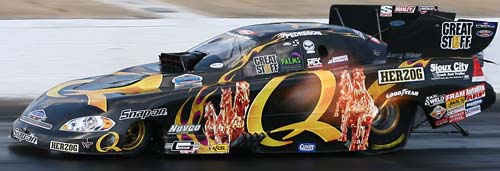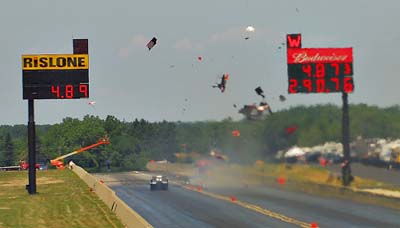THE IMPALA FUNNY CAR BODY WOES
 Funny Car bodies have been
at the forefront of the news lately, with the Toliver/WJ incident getting some
press and also generating a lot of Internet traffic in various chat rooms, but
the Impala body saga is the one that has drawn the most attention from those
affected.
Funny Car bodies have been
at the forefront of the news lately, with the Toliver/WJ incident getting some
press and also generating a lot of Internet traffic in various chat rooms, but
the Impala body saga is the one that has drawn the most attention from those
affected.
Don Prudhomme’s team, as the semi-factory GM operation, was the first to get the new shells, which replaced their previous Monte Carlo bodies. As the highest placed GM team in last year’s points chase it would have been expected that Tony Pedregon would have been next in line for a body. And the projected delivery date for the Quaker State team’s first shell indicated that, but in the end that date was pushed back, and both Tim Wilkerson and Gary Densham had their Impalas before Pedregon. Scuttlebutt at the time suggested that the Pedregon team was bumped to the bottom of the list because Cruz Pedregon was actively courting Toyota. The Japanese auto maker backs Pedregon’s midget team, and it was rumored that he was seeking sponsorship for his Funny Car operation as well. That has ever been confirmed.
Consequently Tony Pedregon did not debut his Impala until the Atlanta race, and on the car’s initial run the body forward of the windshield was destroyed. Crew chief Dickie Venables had the ESPN people on site provide him with a slow motion replay of the incident and it was determined that the area between the burst panel and the injector opening flexed downward three times before fracturing and initiating the breakup of the rest of the forward portion of the body. The body had been mounted with the same basic “tree” structure as was used on the team’s Monte Carlo shells but it was assumed that the different proportions of the body compared with the earlier unit contributed to the failure.

Three mortally damaged bodies and what caused them …

Don Prudhomme’s team, as the semi-factory GM operation, was the first to get the new shells, which replaced their previous Monte Carlo bodies. As the highest placed GM team in last year’s points chase it would have been expected that Tony Pedregon would have been next in line for a body. And the projected delivery date for the Quaker State team’s first shell indicated that, but in the end that date was pushed back, and both Tim Wilkerson and Gary Densham had their Impalas before Pedregon. Scuttlebutt at the time suggested that the Pedregon team was bumped to the bottom of the list because Cruz Pedregon was actively courting Toyota. The Japanese auto maker backs Pedregon’s midget team, and it was rumored that he was seeking sponsorship for his Funny Car operation as well. That has ever been confirmed.
Consequently Tony Pedregon did not debut his Impala until the Atlanta race, and on the car’s initial run the body forward of the windshield was destroyed. Crew chief Dickie Venables had the ESPN people on site provide him with a slow motion replay of the incident and it was determined that the area between the burst panel and the injector opening flexed downward three times before fracturing and initiating the breakup of the rest of the forward portion of the body. The body had been mounted with the same basic “tree” structure as was used on the team’s Monte Carlo shells but it was assumed that the different proportions of the body compared with the earlier unit contributed to the failure.
To explain, the Impala varies in a couple of areas in that it has a much longer roof that puts the windshield base further forward. That results in the windshield being notched at the base to clear the injector hat and leaving less contiguous body surface at the rear of the injector compared with the Monte Carlo which has no notch in the windshield. In addition the horizontal surface of the “cowl induction” bulge in the hood is about 1.5” higher on the Impala whereas on the Monte Carlo the trailing edge of the hood actually sits just above the starter cage on the front of the supercharger providing additional support for that part of the body. After the body was repaired with a new front half the Quaker State team had additional honeycomb reinforcement added to the hood area as well as the sides of the body where they had also experienced problem with the mounting pads breaking through in various places.
a d v e r t i s e m e n t
Click to visit our sponsor's website
 For those who have not
closely studied how a modern Funny Car body is mounted, here’s a quick
tutorial. Mounting pads of various sizes are attached to the inner surface of
the shell and the tubular mounting tree is attached to these pads. Some teams
bond the pads to the inner surface and then overlay them with carbon fiber
while other attach the pads with screws and doubler plates on the outer
surface. Some teams also add hard points at the pad locations, replacing the
honeycomb between the body surfaces with solid epoxy.
For those who have not
closely studied how a modern Funny Car body is mounted, here’s a quick
tutorial. Mounting pads of various sizes are attached to the inner surface of
the shell and the tubular mounting tree is attached to these pads. Some teams
bond the pads to the inner surface and then overlay them with carbon fiber
while other attach the pads with screws and doubler plates on the outer
surface. Some teams also add hard points at the pad locations, replacing the
honeycomb between the body surfaces with solid epoxy.
In the case of the Monte Carlo bodies used by the Quaker State team only a few critical, heavily stressed locations have ever been hard-pointed but since the change to the Impala shell the team have been retroactively adding hard points at many more locations. In fact, at Bristol a pad pushed through the front bumper surface, a failure never experienced with the team’s Monte Carlo shells.
The next stage in the Impala saga came at Norwalk where Del Worsham banged the blower on the CSK car and within an instant was driving a “roadster” as the body shell literally disintegrated, leaving only the portion ahead of the front wheels attached to the chassis. At this point crew chiefs were starting to seriously question the durability of the Impala shells but GM and Roush Composites personnel insisted that the problem was with the mounting procedure not the body itself, citing the fact that Prudhomme’s team had not had any problems and that the McKinney-mounted shells had also been trouble free.
That contention failed to
hold up last weekend at Seattle
when Tommy Johnson Jr banged the supercharger during qualifying. His incident
was a virtual repeat of Worsham’s with the body fracturing from the burst panel
opening across to the top of the front wheel openings. The rest of the shell
stayed basically intact until it rotated vertically on the rear body mount. At
that point it too fractured into a lot of small pieces.
a d v e r t i s e m e n t
Click to visit our sponsor's website

There appear to be a couple of underlying reasons for the failures. The bodies as delivered are approximately 10 pounds lighter than the Monte Carlo and they also have more surface area, which means that they must be thinner overall. There is also a seam in the lay-up of the outer skin which extends from the front corners of the burst panel opening to the top of the front wheel arch and that appears to be the initial failure point in the Worsham and Johnson incidents. In the Skoal car episode the entire sheet metal bulkhead structure was left intact as the bonded mounting flanges were torn out of the inner surface of the shell, again indicating a lack of integrity in the original body.
As this is written all of the Impala shells currently in service are being cycled through a facility in California having addition reinforcing material added at the high stress points where the failures have been occurring. Hopefully this weekend’s event at Sonoma will see the drivers a little more confident that they will not suddenly be driving a roadster.
| {loadposition feedback} |




